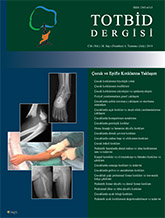
Tibial and fibular fractures are the third most common pediatric long bone injuries after forearm and femoral fractures. Proximal tibial injuries have an increasing frequency in recent years, parallel with the increasing sports activities of the children and adolescents. The clinical significance of proximal tibial fractures arises from the presence of the growth plate and the close proximity to the neurovascular structures. Anterior-posterior and lateral X-ray imaging is used for diagnosis. Advanced imaging methods (i.e., computed tomography, magnetic resonance imaging) can be used in suspected cases. The amount of displacement is usually decisive for the treatment method. Regardless of which treatment is used, the main objective is to achieve and maintain the appropriate alignment in order to prevent deformity and degenerative joint disease. The mechanisms of injury for tibial and fibular diaphyseal fractures are falls, sport injuries and traffic accidents. Clinical signs may differ depending on the fracture mechanism, and the treatment options are age-related. Majority of fractures can be treated with conservative modalities. In case of older children and/or unacceptable misalignments, surgical procedures (e.g., fixation with K-wires, titanium elastic nails, plate/screws, external fixators) can be preferred.